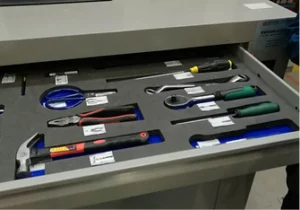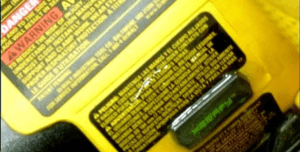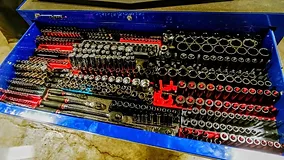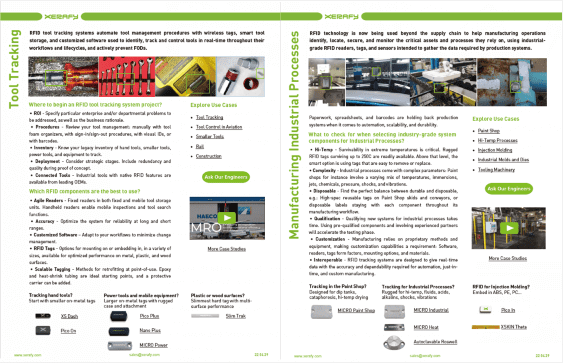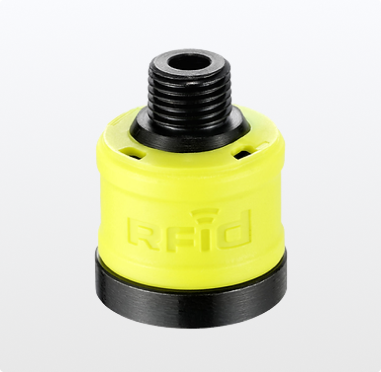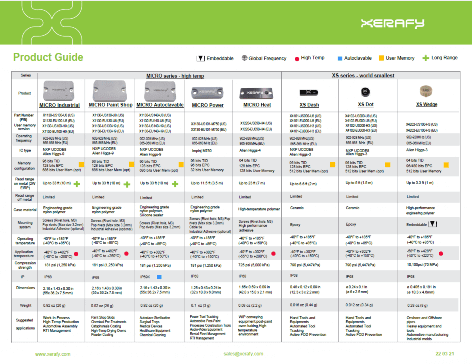Tool Tracking
With RFID Systems
Management of tool inventory in mission-critical operations to actively prevent FOD and save time.
Tool tracking plays its role in mission-critical operations where effective tool inventory management and accountability are key to actively preventing FOD incidents and promoting time savings.
RFID tool tracking generates a positive return on investment by primarily saving costs for replacing lost or stolen tools. Furthermore, it provides valuable data on the history, usage, and preventive maintenance of each tool, enabling informed decisions regarding purchasing or selling tools that contribute to saving both time and money for the company.
Several industries are successfully implementing RFID tool tracking systems, with case studies available in aerospace, rail, defense, nuclear, automotive, semiconductors, and construction.
FOD prevention drives the adoption of RFID tool tracking systems in mission-critical operations such as aerospace, where unaccounted tools and other maintenance incidents can have catastrophic consequences.
Aerospace tool control procedures traditionally rely on visual tool identifications such as tool foam organizers for toolboxes and drawers. Tool cribs and sign-in/sign-out procedures provide another level of control but with limited efficacy and accuracy.
Aircraft MRO operations have been early adopters of tool crib software and solutions, setting the standard for how other industries can address their own safety, compliance, and productivity challenges.
Automated Tool Control (ATC) solutions are now available that bring tool control RFID systems to drive safety, efficiency, and digitization.
The ATC solutions are built around multiple smart RFID-enabled mobile and fixed tool storage options, including tool crib, tool trolley, tool cart, tool cabinet, CICO kiosk, tool room, toolbox.
Industrial operations rely on specialized tools and equipment: Securing them from theft and locating them quickly when they are needed is critically important in their daily operations.
By improving both the accuracy and the effectiveness of tool tracking, RFID tool tracking reduces the substantial costs of tool availability and life cycle.
The limitations of manual tool tracking in industrial environments are well documented:
- Loss of tools, due to misplacement or outright theft, and therefore the direct cost of replacement
- Lost productivity due to personnel check-out/check-in of tools, searching for lost tools, or waiting for replacements to arrive
- Poor customer satisfaction from missed commitments, maintenance, and added cost
Sockets, ratchets, drills bits: Managing smaller tools presents a sizeable challenge.
With sockets and ratchets accounting for up to 30% of a typical MRO tool inventory, delivering a near 100% tool tracking coverage is critical in environments prone to FME and FOD incidents.
But given their small sizes, traditional tool tagging solutions are limited given that there really is no good place to mount an RFID tag that won’t interfere with daily operation.
The automotive industry provides examples of tool tracking systems applied to tooling and equipment.
General Motors has a dedicated team in charge of thousands of tooling equipment involved in the manufacturing of critical components. With tooling distributed across hundreds of sites within a complex production and supply organization, managing tooling equipment has become a key feature of GM suppliers’ organization.
Benefits of RFID for Tool Tracking
FOD Prevention
Locate lost tools by providing visibility into tool usage and potentially identifying the last known location of the tools
Productivity
Analyze tool management processes and identify any inefficiencies, challenges, or pain points that are affecting operations
Visibility
Offer visibility into the last known location or usage of tools, enabling companies to track and monitor tool movements, and have a record of when a tool was last seen
Maintenance
Evaluate the condition and usage of tools, allowing to assess if any tools are damaged, require calibration, and make informed decisions on whether replacements are needed
Analytics
Assess tool inventory and usage, allowing to identify any gaps or shortages in tools and make informed decisions about the need for additional tools
What are the challenges of tool tracking?
Aerospace and industrial operations have first-hand experiences of the limitations of manual tool tracking relying on tool foam organizers, sign-in/sign-out procedures, visual identifiers, or barcodes.
Cost
Loss of tools due to misplacement or outright theft, and therefore the direct cost of replacement.
Visibility
Up-to-date information of availability of specific tools and kits.
productivity
Lost productivity due to lengthy manual check-out/check-in procedures of tools.
Safety
FOD risks of lost or unaccounted tools.
reputation
Reputational risks from missed commitments and added costs.
Why is UHF RFID preferred for a tool tracking system?
UHF RFID is preferred for tool tracking systems because it has a longer read range compared to other tracking technologies such as barcodes or QR codes.
The longer read range enables systems to inventory many tools simultaneously, automatically in an RFID-enabled tool crib, or using a handheld UHF RFID reader that also allows for tool locating.
Passive UHF RFID (aka RAIN RFID) in particular does not require any battery, therefore reducing costs and limiting the need for additional maintenance.
Moreover, RFID tags are rugged and durable, making them suitable for physically demanding environments.
How do you setup an RFID tool tracking system?
A tool tracking system automates all tool inventory management procedures by using wireless tags and RFID readers, with the option to deploy smart tool storage such as an RFID toolbox and customized tool crib software, to identify, track and control tools in real-time throughout their workflow and lifecycle.
The solution will integrate all the components for optimal accuracy at long and short ranges, and for work in a high density of metal surfaces:
- RFID Readers – Fixed RFID readers are used to inventory an area continuously, at set intervals, or after key events like doors opening. Mobile/handheld readers, on the other hand, enable mobile inspections and tool search functions, allowing for flexibility in when and where the inventory is taken. They can be incorporated in both fixed and mobile tool storage units such as cribs, drawers, cabinets, and toolrooms.
- RFID-tagged Tools – Tools are tagged using RFID for mounting on metal and for embedding, available in a variety of small sizes to accommodate even the most limited available real estate. Tags are all available for optimized performance on metal, plastic, and wood surfaces. Tags can be deployed at scale, offering resistance to shocks, abrasion, fluids, and chemicals, with epoxy and heat-shrink tubing a common retrofit method at point-of-use.
- Customized Software – Adapt to your workflows to minimize change management. Update for additional capabilities: Alerts for missing tools, calibration notifications, replenishment triggers, override options, and data insights.
- Access Control – An access control system will allow controlling access to all or specialty tools, based on a physical location such as an area, room, van, trailer, shelves, displays, cabinets, tool boxes, or even custom vending machines.
RFID tool tracking implementation best practices
Common questions faced when deciding on implementing a tool tracking system:
- Will it provide accurate and real-time tracking data?
- Can it handle the volume and variety of tools in our inventory?
- What are the implementation costs and potential return on investment?
- How will it integrate with our existing systems and workflows?
- Will it improve efficiency and reduce tool loss or theft?
The steps involved in determining the right system for tool tracking include evaluating the specific requirements of the organization, understanding the capabilities and limitations of the technology, considering the cost-benefit analysis, and assessing if it can effectively address the identified challenges in tool tracking.
Additional resources such as case studies, white papers, and videos are available to learn about deploying RFID systems for tool tracking, as well as support from the Xerafy engineering team.
ROI
Specify particular enterprise and/or departmental problems to be addressed, as well as the business rationale.
Procedures
Review your tool management, whether it is done manually with tool foam organizers, with sign-in/sign-out procedures, with visual IDs, or with barcodes.
Inventory
Know your legacy inventory of hand tools, smaller tools, power tools, and equipment to track. Include storage units in use for tools.
Deployment
Consider strategic stages, such as team, department, and enterprise-level deployment. Include redundancy and quality during proof of concept.
Connected Tools
Industrial tools with native RFID features are available from leading OEMs: A short-term alternative to retrofitting or a long-term direction for procurement.
What tool tracking tags to use?
Xerafy has developed a unique range of rugged RFID tagging solutions, built on overcoming several challenges of traditional RFID technology relating to tool tracking when it comes to metal interference, harsh environments, and long-range read distance requirements.
What are Connected Tools?
Connected Tools are professional tools coming with native RFID features to enable tracking, identification, location, usage data capture.
Unlike retrofit tools that gain RFID features at point-of-use, Connected Tools see the RFID chip integrated into the very design of the item and embedded by the manufacturer.
Xerafy has pioneered this new approach with leading manufacturers such as Stanley Black & Decker (for its Cribmaster, Proto, and Facom brands), Kyoto Tool, SnapOn. Tool manufacturers respond to the strong interest for evolutions in tool management and FOD prevention.
Get In Touch
If you have any questions or need help, feel free to contact with our team.
